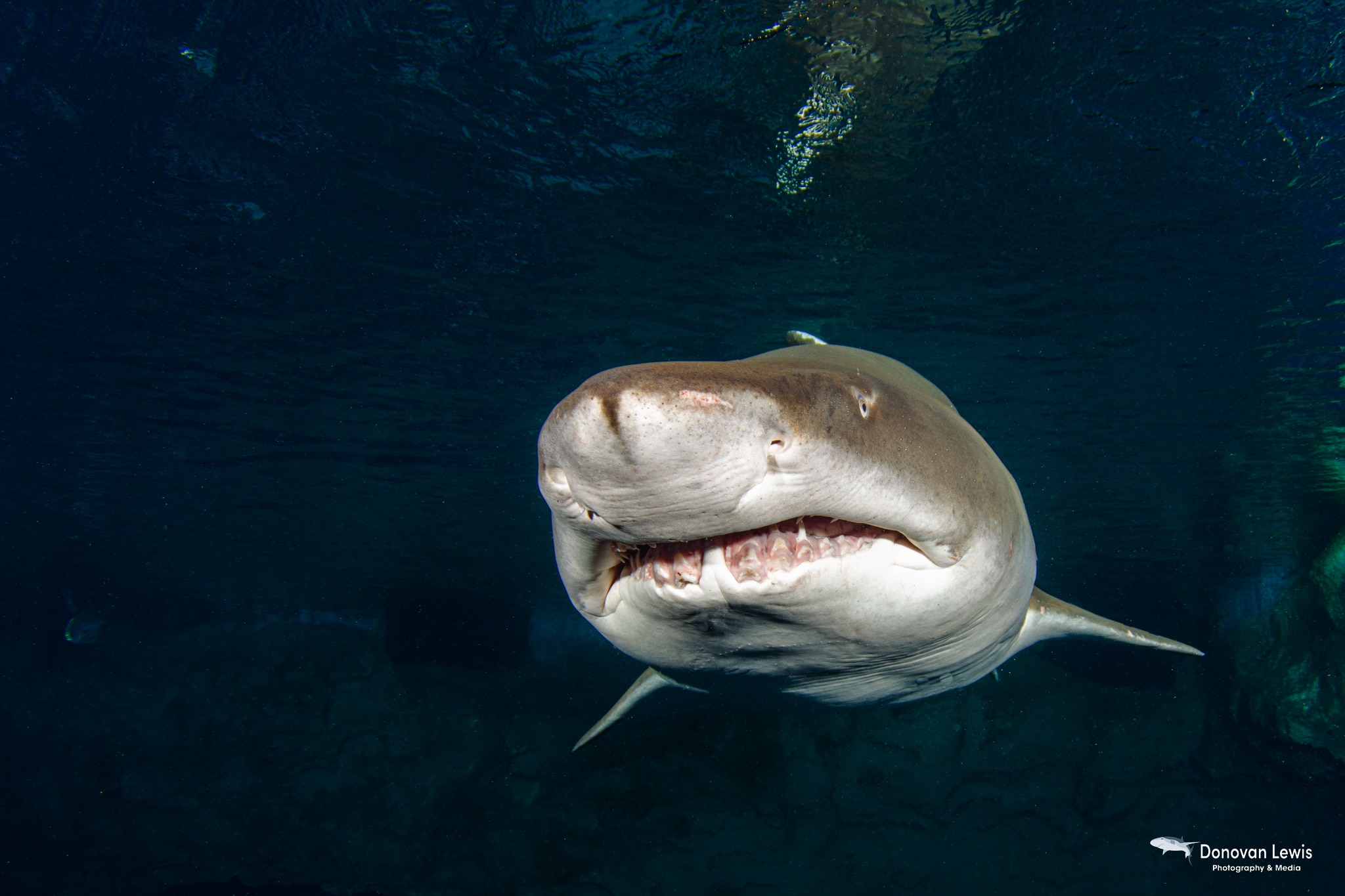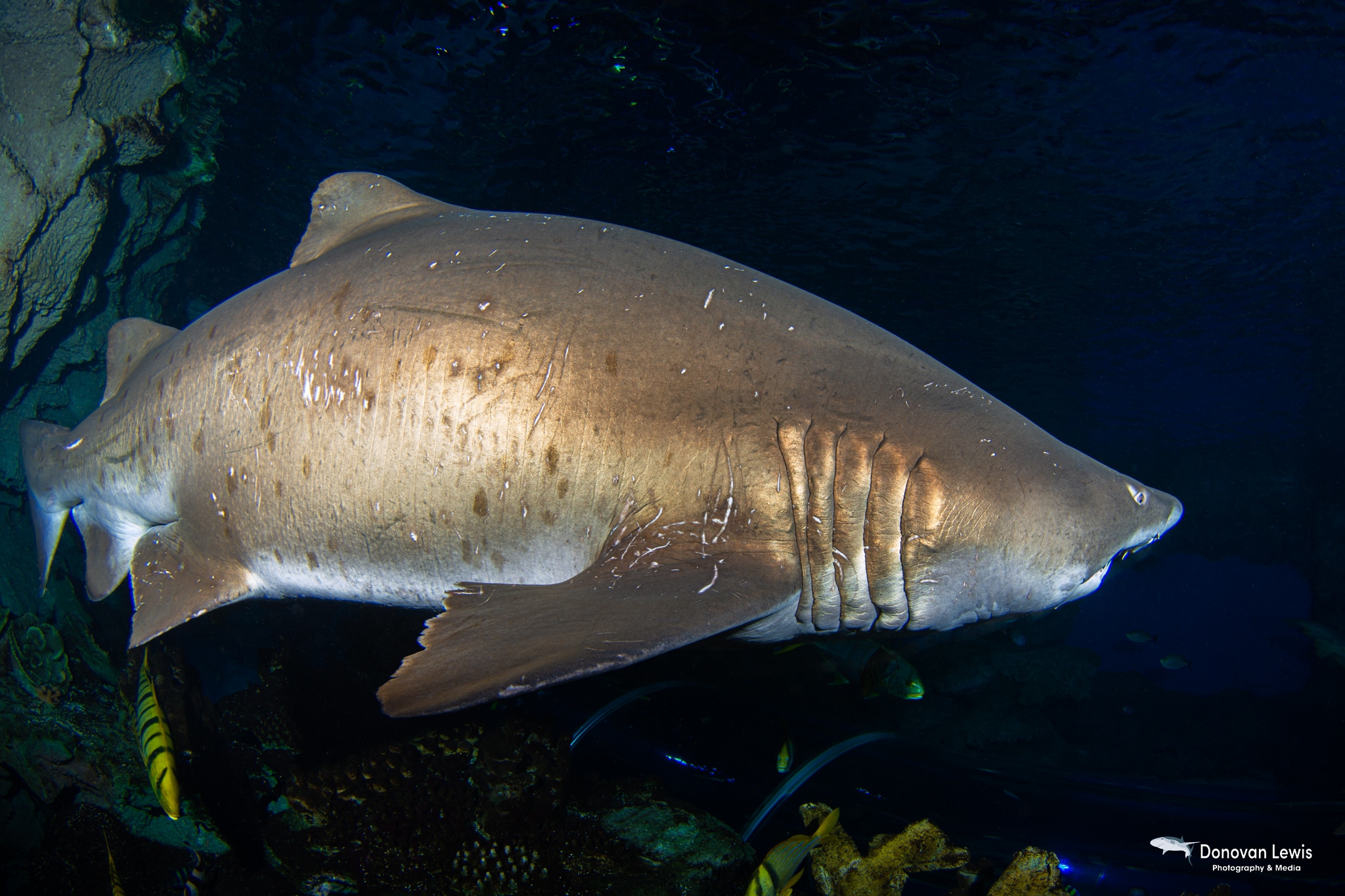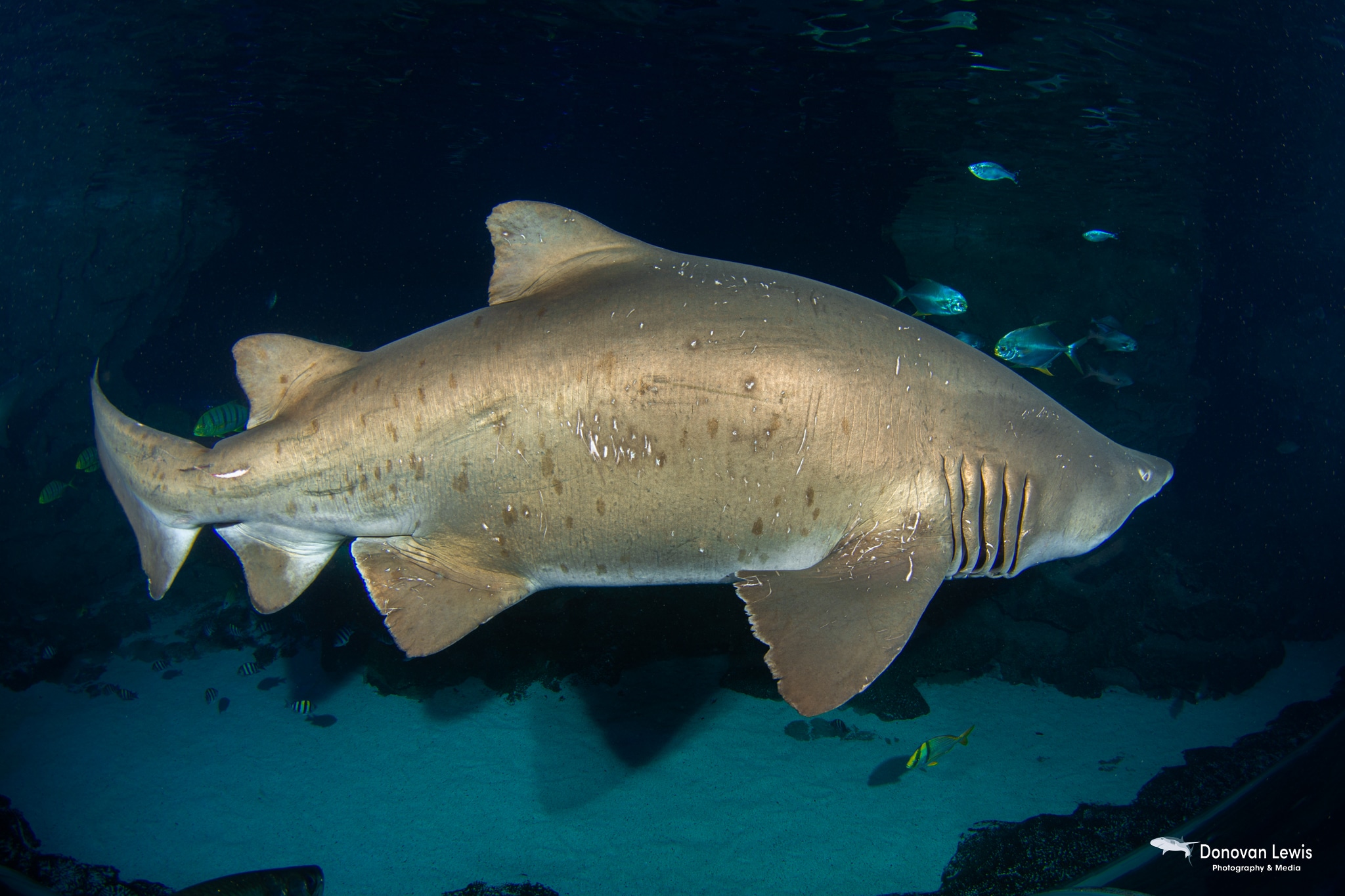Marine Life & Conservation Blogs
Love is in the air at Blue Planet Aquarium

Every year between the end of January and mid-May when the water is at its coldest and begins to warm up for summer, Blue Planet Aquarium has its annual Sand Tiger Shark mating season. During this time of year, the dynamics in the tank completely change, from what are usually slow moving and often sleeping sharks turn into fast moving Sharks who have only one thing on their mind.
In previous blogs I’ve mentioned how relaxed the Sharks are, but during this time the Sharks are at the complete opposite end of the scale, sometimes seeming oblivious to our presence, they can tend to almost “play chicken” with the divers, swimming very close, which can sometimes make us jump a little. Even with this change in behaviour however the animals are still quite easy to work with and we always respect their boundaries and rules as it is their home at the end of the day.
The changes in behaviour start around mid to late January with a huge reduction in appetite for all our Sand Tigers, they will go down to eating almost nothing throughout the mating season, we even have them spit food out after grabbing it.
The next sign usually starts with the males moving a lot faster and will duck and dive between the different levels in the tank, it can be chaotic one day and then almost nothing the next, on the opposite end the females will slow right down and tend to spend a large amount of time either on or near the bottom.
It is like this for about a month before the action really starts, the next sign is what’s known as “tracking”, this is where you will have the female of interest at the front with the alpha male close behind her, with the subordinate males trailing behind him. This happens for a couple of weeks until around March where the height of mating season starts, after a month or so of tracking and a little bit of bickering there will be an “alpha” male who will control mating in the tank. Alpha males will then protect the area where females are congregating and will then force less dominant males out by snapping their jaws at them, snapping tends to be enough to force males out, however seeing bite marks on the males is not uncommon.
When Sharks mate the males tend to bite the females around their pectoral fins or on their sides, this is done to help hold themselves in place during mating and to make it easier to mate by slowing the female down, females will often resist but will concede due to the extra weight, this could be the female testing the male’s fitness, but we honestly don’t know. The male sharks sex organs are known as Claspers, two small appendages that trail behind the Sharks pelvic fins and its these that transfer the Sperm to the female during mating, they have two so that they’re able to effectively mate no matter what side they approach the female on.
When males are finished and let go, they can sometimes leave teeth embedded in the females which will fall out after a few days and don’t affect the female long term, this does often result with toothless males during mating season, and even for a short time after it has finished, which our guests are often surprised to see gummy Sand Tigers in our exhibit. Along with having toothless males the females also become covered from nose to tail in love bites, and during rather amorous seasons the dive team will refer to the females as pin cushion Sharks due to how much they resemble pin cushions, never fear however because mere days after mating season has finished most, if not all, of the wounds on a female would have healed and results in very minor scarring or marks.
Females will mate with numerous males throughout a season, moving between different areas and mating with many alpha males who control those areas, in the case of Blue Planets main tank our males tend to gain and lose alpha status rather regularly, thus allowing them mating rights. Female Sand Tigers have two Uterus’s which can contain up to 5 pups each. After the mating season is over, females become pregnant in a rather remarkable way. Sand Tigers are known as oophagous which is where the developing embryos will feed on undeveloped eggs produced by the mother throughout her 9–12-month pregnancy.
But that’s not all, once an individual or individuals reach a certain size, they will actually turn on their sibling and begin to feed on them, this is called intrauterine cannibalism. This will continue until there is a single fully toothed pup in each uterus, however triplets have been recorded which believed to be two individuals from the same womb who were full sibling who teamed up, and one from the other womb.
This method of eating siblings is believed to be an adaptation by male Sand Tigers with whom who can father the most well-armed, active hunting embryos as described by a scientist called Damian Chapman.
Unfortunately, Blue Planet has never had a captive natural birth in our main exhibit now there could be many reasons as to why this is the case, and we have a few theories amongst the team but unfortunately, we just can’t say for certain what those are. The reasons as to why they aren’t breeding is something that been discussed for many years in aquariums across the globe as unfortunately captive breeding very limited with only a handful of recorded births worldwide.
Sand Tiger Sharks have one of the lowest reproductive rates of any Shark Species giving birth to only two pups every other year as the females take a rest year in between, on top of this Sand Tigers don’t become sexually mature until they’re between 6-7 if they’re a male, females will not become mature until they’re 9-10 this on top of the fact that the maximum lifespan recorded for a Sand Tiger in the wild is 15-17 years means that to be generous, a female may only give birth to a maximum of 16 pups throughout their lifetime. Now these natural adaptations have served them well throughout the last 450 million years but now they are a handicap.
Sand Tigers are unfortunately at threat, with some populations such as those in Europe, the Mediterranean and Eastern Australia classified as Critically Endangered. Sand Tiger Sharks were also the first Shark species to be put on the endangered species list and given full protection which was first done in Australia.
With all the odds stacking against them its now even more imperative that we learn more about these incredible animals and how to breed them effectively to create a captive population as a contingency plan in case things in the wild take a nosedive. Therefore, Zoos and Aquariums are important to the wild members of a species with housed members of the species, helping ensure their survival and as acting as ambassadors to the wild ancestors by educating our guests and the public for many years to come. Now rest assured although we haven’t yet been able to breed Sand Tiger Sharks in our main exhibit, we’re working hard to better understand and figure out how we can in the not-so-distant future.
For more about Blue Planet Aquarium visit their website by click here.
Blogs
Saba’s Plan for a Coral Comeback

Saba has an exciting new initiative to restore its coral reefs. This new project, running from 2024 to 2026, will focus on reviving key species in the island’s underwater ecosystems. With a collaborative team from the Saba Conservation Foundation (SCF) and Van Hall Larenstein (VHL) University of Applied Sciences, the project aims to restore both corals as well as sea urchins.
This initiative is centered around coral restoration, specifically reviving two essential coral species—staghorn coral (Acropora cervicornis) and elkhorn coral (Acropora palmata). By mapping parent colonies and using a technique known as coral gardening, SCF will create and maintain coral nurseries. These corals will eventually be outplanted at key reef sites around Saba to not only expand the number of coral colonies, but also provide essential fish habitat. The project focusses on installing coral nurseries, training staff with the newest techniques and starting with the restoration of key reef sites.

Reef Cleaners to the Rescue
It’s not just corals getting a makeover—this project also shines a spotlight on the essential role of grazers, particularly sea urchins. VHL is leading the charge on cultivating and restocking two key sea urchin species, West Indian sea egg (Tripneustes) and long-spined sea urchin (Diadema), known for their ability to keep algae in check. By removing algae, which are important competitors of corals, they help the coral to thrive. By restoring these “reef cleaners,” Saba’s project will give corals the breathing room they need to grow, setting the stage for a healthier, more balanced marine ecosystem.
From Tiny Urchins to Big Goals
The project will be funded as part of the Dutch Government’s Nature and Environment Policy Plan (NEPP) 2020-2030 for the Caribbean Netherlands, a comprehensive initiative aimed at conserving and restoring the unique natural environments of the Dutch Caribbean islands, including Saba, St. Eustatius, and Bonaire. This project is aiming for big milestones: build and maintaining coral nurseries, the expansion of urchin cultivation facilities, and the creation of a dedicated research center. By 2026, the project hopes to ramp up coral and grazer restoration, with the ultimate goal of extending these efforts across the Dutch Caribbean. By linking local initiatives to broader regional goals, Saba’s restoration project promises to leave a lasting impact on both the environment and the community.
Find out more about the DCNA at dcnanature.org.
Blogs
Reef-World marks two decades of marine conservation: strengthening impact amid coral reef threats

Empowering ocean stakeholders to tackle future challenges and ensure the survival of coral reefs and humanity
2024 marks the 20th Anniversary of The Reef-World Foundation’s tireless efforts for global coral reef conservation. The UK charity is the international coordinator of the UN Environment Programme’s Green Fins initiative, known as the leading voice in sustainable marine tourism. Today, Reef-World released its 2023-2024 Impact Report outlining a year of substantive growth and impact in its marine conservation programmes.

Impact Report Highlights:
- Impressive improvements in environmental behaviours to protect coral reefs by the marine tourism industry as the global participation of Green Fins increases.
- Continued capacity building for government and NGO staff to effectively manage marine tourism activities in Asia, Caribbean and Red Sea regions.
- For the first time in Green Fins’ 20-year history, tourism operators have achieved ‘Best Environmental Performer’ status by demonstrating the lowest possible environmental impact in their environmental assessments. In 2024, three dive operators achieved this challenging milestone.
- Significant increases in global participation of Reef-World’s innovative digital conservation tools.
- 138 Green Fins dive operator members achieved the strict threshold for PADI Eco Center recognition.
- Developed four new educational materials and translated two into 16 languages to support the marine tourism industry in achieving sustainability targets.
- Establishing a new Reef-World Development strategy and recruiting new roles – Development and Programmes Managers.
- Reef-World’s board welcomes new Chair and Trustees strengthening organisational leadership.

Reef-World started as a one-person mission to inspire and empower communities to act in conserving and sustainably developing coral reefs and related ecosystems. Today, the team of 12 continues to meet this mission by inspiring and empowering the global marine tourism community to be exemplary sustainability leaders by using the Green Fins guidelines and tools to simultaneously use and protect the world’s precious reefs.
In April 2024, the fourth global coral reef bleaching event was confirmed. Reef-World’s work has never been more urgent as the marine environment, and the benefits they provide humanity, continue to be eroded by global threats. The reduction of local threats, like those from the marine tourism industry, is an essential step to ensuring a future where coral reefs survive and continue to support the millions of people who depend on their ecosystem benefits. Reef-World’s work buys time for coral reefs and related ecosystems to be resilient to the impacts of global threats.
“Right now our corals are facing the greatest fight of their existence as the terrifying predictions of the steps towards their complete extinction are starting to come true. But all is not lost, reefs are resilient and they have existed on this planet for millions of years. We must take action now, to buy time for reefs by reducing threats facing them and allowing them to react and adjust to the changing environment they need to survive in.” – Chloe Harvey, Executive Director
Looking Forwards:
Like coral reefs, the Reef-World team needs to be resilient in the face of the complex challenges of the conservation sector. Reef-World has invested significantly in developing a Culture of Care to ensure the well-being of its team on a daily basis, continuing to be an exemplary employer to enable its team to best achieve the mission for coral reef conservation.
With the foundations of a Culture of Care and organisational development laid, Reef-World is emerging from the end of a natural organisation life cycle, that brings the challenges of growth and scale, stronger than ever. With a new strategy in place to generate much needed resources, Reef-World is excited for the opportunities to leap forward, continue to scale our impact and lean into new innovations and untapped opportunities for marine conservation.
We continually strive to become a forward-thinking organisation that delivers on our goals and commitments to our stakeholders with fresh approaches and not being afraid of steering away from a “normal approach.” This approach is not only applied to our programmes of work but also internally and carries over to our Culture of Care for our team.” — JJ Harvey, Operations Director

The Reef-World Foundation is immensely grateful for the continued support of its grant funders: UN Environment Programme, IUCN’s Blue Natural Capital Financing Facility, Adventure Travel Conservation Fund, PADI Aware Foundation, and World Nomads Footprints Program.
Reef-World would also like to express its gratitude to international partners whose vital support has resulted in significant tangible benefits for our work and mission: PADI; Professional SCUBA Schools International (PSS); Explorer Ventures; 1% for the Planet; ZuBlu; Snorkel Venture, GSTC; Dive O’Clock; Seven Dragons; DiveAssure and Eco Beach, without whom these achievements would not be possible.
The full 2023–2024 Annual Impact Report is available on Reef-World’s website.
-

 News1 month ago
News1 month agoIconic SS United States to become the World’s Largest Artificial Reef
-

 Blogs3 months ago
Blogs3 months agoNovoScuba’s Game-Changing Approach for Dive Store Owners: WE PAY YOU!
-

 News2 months ago
News2 months agoBook Review – 52 Assignments: Underwater Photography
-

 Gear News2 months ago
Gear News2 months agoDYNAMICNORD – New German diving brand enters the British market
-

 News2 months ago
News2 months agoExploring Cenote El Pit: A Diver’s Dream
-

 Gear News2 months ago
Gear News2 months agoTry BARE drysuits (and maybe even win one!) this Friday with Sea & Sea at North West Dive Fest
-

 News3 months ago
News3 months agoComing Soon – 52 Assignments
-

 News3 months ago
News3 months agoSave £200 per person per week at Pole Pole Lodge with Dive Worldwide
















